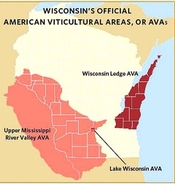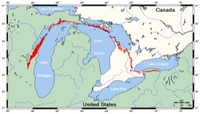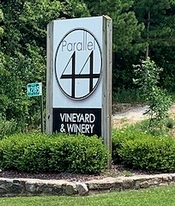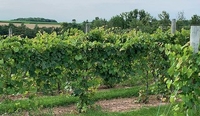Wisconsin, although justifiably famous for agriculture, is not well known for wine production. The state does have an intriguing wine history, though. Agoston Harazthy planted his first vineyard in the USA along the Wisconsin River in 1846. Harazthy turned his focus westward two years later, but his initial vineyard site is now part of the Wollersheim Winery vineyards north of Madison.
Tucked in amongst the many corn and soybean fields of the Badger State, there is a growing wine industry. There are only around 100+ wineries now operating in the Wisconsin. Compare that to the
seven thousand registered Wisconsin dairy farms. Although very small in numbers, these pioneering wineries show that fine wine can be produced here. Almost all Wisconsin wineries are working with cold-hardy varieties bred for the harsh winters experienced in the state. One ancillary advantage is that wineries can produce ice wine nearly every year if they choose.
There are many winegrowing areas throughout the USA that, while not on the radar of the wine press, are well worth visiting. The Wisconsin Ledge AVA is one of these areas. Established in 2012, the AVA encompasses some 3800 square miles – nearly 2.5 million acres. Only about 400 of those acres are planted to wine grapes, however, and there are only two dozen bonded wineries within the AVA. But that leaves lots of room to grow, and there are promising signs for producing high-quality wines.

Location of the Wisconsin Ledge AVA
The story of the Wisconsin Ledge is closely tied to the underlying geology of the region. The Ledge is an outcrop of Silurian-age dolomite that was deposited some 425 million years ago in a shallow, tropical sea. Continents have moved far from that position in the intervening eons, but the residual effect remains. This broad arc of hard carbonate rocks extends from New York State, through Canada’s Ontario province and Michigan and into the modern state of Wisconsin. In its arc, the Niagara Escarpment, as it is known, creates Niagara Falls, influences the vineyards of Ontario, separates the lobes of Lake Huron and creates the spine of the Door Peninsula that juts into Lake Michigan north and east of Green Bay.
 The Niagara Escarpment Extends Across the Great Lakes Region
The Niagara Escarpment Extends Across the Great Lakes Region
The result is the Wisconsin Ledge. The dolomite beds form a cuesta, rising at a shallow angle from Lake Michigan to the east, and creating a steep slope overlooking Green Bay. The hard Silurian rocks affected the multiple glacial advances over the last two million years. Glacial ice scoured out Green Bay and Lake Michigan, leaving the promontory of rock that is the Door Peninsula. The proximity of Lake Michigan moderates the climate here, giving grape growers just a bit more warmth and length of growing season that translates to higher quality wine grapes
There are currently 24 bonded wineries in the Wisconsin Ledge AVA. Many, even most, bring in grapes from California, New York and Washington to supplement local production. Those that have local vineyards are planting varieties like La Crescent, Frontenac, Frontenac Gris, Marquette, St. Croix, Petite Pearl, Edelweiss, Brianna and more. While these are unfamiliar names to most wine drinkers, they are becoming better known as wineries throughout the central U.S. vinify them. It remains a marketing problem as many consumers will shy away from unfamiliar grape varieties, but the adventurous taster will be rewarded. Many wineries focus on sweeter styles that are popular in the tasting room and balance the sometimes-high acidities of these new varieties. There is more to sample than just dessert wines, however, and they can offer the wine enthusiast delicious experiences.

The Parallel 44 Vineyard and Winery in Kewaunee, WI
A snapshot of the potential of Wisconsin Ledge wines is offered by the Door 44 / Parallel 44 vineyards and wineries. These two sibling wineries offer a real instruction on the character of cold-hardy grapes across a range of wine styles. Highlights of my tasting included the following:
NV Bubbler: A sparkling wine from La Crescent and Frontenac Gris with brilliantly pure citrus and green apple fruit; its clean and refreshing character make it a perfect summertime sipper or an apéritif at any time of the year.
2020 Imagine: Made from a grape named Louise Swenson by legendary grape breeder Elmer Swenson. As the University of Minnesota states: “This grape should be grown much more widely in the North for its consistent wine quality, outstanding winter hardiness, and good cultural behavior.” The Door 44 “Imagine” Louise Swenson is fresh, clean, pure and invigorating with lemon and lime nuances and a refreshing finish.
2020 La Crescent: This grape was released in 2002 by the University of Minnesota breeding program, a source of many cold-hardy varieties. The wine is floral and fresh with citrus peel and tropical fruit character. Off-dry on the palate, the subtle sweetness balances the inherent tart character of the grape.
2020 Petite Rosé: This is a delicious rosé made from Petite Pearl grapes – a variety from Minnesota grape breeder Tom Plocher. The wine is pure and bright, with pure red cherry fruit and a touch of peach character underlain by a lovely refreshing acidity.
2019 “M”: Made from Wisconsin Ledge Marquette grapes, this dry red shows intense red cherry fruit with hints of cocoa and herbs. The balanced, layered flavors linger well. A tasting of the still fresh and vibrant 2017 vintage shows that Marquette can age gracefully as well.
2018 Petite Pearl Reserve: Petite Pearl has real promise as a red grape for this cold climate AVA. Ripe black cherry and blackberry fruits are enhanced by hints of herbs, cocoa and baking spices. This is a wine to look for in this and future vintages.
 Vineyard at Cold Country Vines & Wines on the Door Peninsula
Vineyard at Cold Country Vines & Wines on the Door Peninsula
The Door Peninsula is a delightful place to visit on its own. The opportunity to visit wineries and sample local wines just adds to the attraction. Stop for a traditional fish boil or sample freshly-caught whitefish or walleye along with a glass of local wine – you’ll be enchanted by the experience. Explore the Wisconsin Ledge AVA if you travel to the area. It’s a most interesting journey.